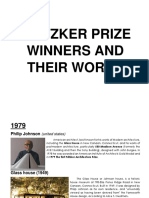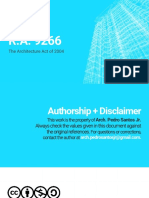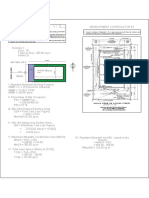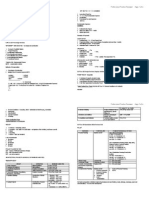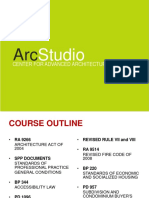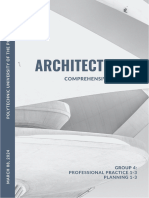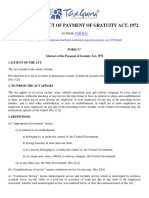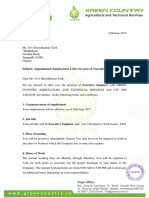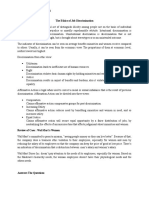Professional Documents
Culture Documents
Quiz 1: RA 9266: Comprehensive Regulation For The Registration, Licensing and Practice of Architecture
Quiz 1: RA 9266: Comprehensive Regulation For The Registration, Licensing and Practice of Architecture
Uploaded by
Alvin Sabiaga100%(2)100% found this document useful (2 votes)
2K views6 pagesRA 9266
Original Title
PP Pedro RA 9266
Copyright
© © All Rights Reserved
Available Formats
DOCX, PDF, TXT or read online from Scribd
Share this document
Did you find this document useful?
Is this content inappropriate?
Report this DocumentRA 9266
Copyright:
© All Rights Reserved
Available Formats
Download as DOCX, PDF, TXT or read online from Scribd
Download as docx, pdf, or txt
100%(2)100% found this document useful (2 votes)
2K views6 pagesQuiz 1: RA 9266: Comprehensive Regulation For The Registration, Licensing and Practice of Architecture
Quiz 1: RA 9266: Comprehensive Regulation For The Registration, Licensing and Practice of Architecture
Uploaded by
Alvin SabiagaRA 9266
Copyright:
© All Rights Reserved
Available Formats
Download as DOCX, PDF, TXT or read online from Scribd
Download as docx, pdf, or txt
You are on page 1of 6
Quiz 1: RA 9266
Thursday, January 21, 2021
7:59 PM
1. What is the full title of RA 9266?
a. The Architecture Act of 2004
b. An Act Providing For A More Responsive And
Comprehensive Regulation For The Registration,
Licensing And Practice Of Architecture
c. An Act To Regulate The Practice of Architecture In The
Philippinen
d. Standards of Professional Practice
e. Code of Ethical Conduct for Architects
1. The architect who is directly and professionally responsible for the
total design of the project for the client and who shall assume the
civil liability for the plans.
a. Architect
b. Architect-of-Record
c. Architect-in-Charge-of-Construction
d. Consulting Architect
e. Professional Architect
1. Who nominates persons for each position in the PRBArch?
a. The IAPOA
b. The outgoing members of the PRBArch
c. The President of the Philippines
d. Any registered and licensed architect may nominate
persons for vacant positions in the PRBArch
e. Any citizen of the Philippines
1. A certificate bearing a registration number signifying that the
individual has successfully passed the licensure examination and is
registered to practice his/her profession as architect
a. Certificate of Examination
b. Certificate of Registration
c. Certification of Licensure
d. Professional Certification
1. An architect who is professionally and academically qualified and
with exceptional or recognized expertise or specialization in any
branch of architecture
a. Architect
b. Architect-of-Record
c. Architect-in-Charge-of-Construction
a. Consulting Architect
a. Professional Architect
1. How much of the owners, shareholders, etc. of architectural
corporations must be registered and licensed architects?
a. 50% + 1
b. At least 50%
c. 75% + 1
d. At least 75%
e. Both C and D
1. Does the consulting architect assume any civil liability under the Civil
Code?
a. No. Only the architect-of-record assumes the civil
liability in all circumstances.
b. Yes, but only if the consulting architect contravenes
the legal and professional functions of the architect-
of-record.
c. Of course. The consulting architect is a professional and
therefore always carries a civil liability.
d. Yes, but only if the consulting architect renders advice on
matters that are outside of his/her area of expertise.
e. Both C and D
1. A document which contains the norms and principles governing the
practice of the profession of architecture in the highest standards of
ethical conduct.
a. The Architecture Act
b. Standards of Professional Practice
c. Architect’s Credo
d. UAP Documents
e. Code of Ethical Conduct
1. A duly notarized written contract stipulating the scope of services
and guaranteeing compensation for such services that the architect
will render.
a. Service Agreement
b. Preliminary Conditions
c. Schedule of Fees
d. Scope of Work
e. Proposal
1. Which of the following is true?
a. All registered and licensed architects may join any
organization for architects.
b. All registered and licensed architects are required to be
members of the UAP because it is the IAPOA.
c. Both A and B
d. All of the above are false.
e. Both B and D
1. The term “architectural company” is synonymous to
a. Architectural corporation
b. Architectural partnership
c. Sole proprietorship
d. The term “architectural company” may refer to all three:
corporation, partnership, or sole proprietorship.
e. Both A and B
1. The following are considered part of the contract documents, except
for:
a. Code of Ethical Conduct
b. Standards of Professional Practice
c. UAP Documents
d. Both A and B
e. None of these are part of the contract documents
1. The intellectual property rights retained by an architect over any
architectural documents/work that he/she prepares unless there is a
written stipulation to the contrary.
a. Ownership
b. Copyright
c. Authorship
d. Property
1. Documents which define all aspects of professional service,
prescribes minimum basic fees and establishes the rights and
obligations of both the architect and the client.
a. Code of Ethical Conduct
b. Standards of Professional Practice
c. Schedule of Fees
d. General Conditions
e. Architect's Credo
1. Who shall prepare the syllabi for the licensure exams?
a. The PRC
b. The PRBArch
c. The UAP
d. The academe
e. The IAPOA
1. Who shall develop the CPD program for architects?
a. The PRBArch
b. The IAPOA
c. The PRC
d. The academe
e. The CPD providers
1. Does the architect have the right to control the construction of any
building that only partly reproduces his design?
a. Yes.
b. No.
c. Only if the design is copied exactly, without any
modifications.
d. Only if the owner of the building hired the architect to
design the building.
e. Only if the design was formally copyrighted.
1. The proprietary rights to an architectural work by a person who
commissions the Architect.
a. Ownership
b. Copyright
c. Authorship
d. Property
e. Usufruct
1. How often must the Certificate of Registration be renewed?
a. Every year
b. Every three years
c. Every four years
d. It never expires.
e. It must be renewed whenever the PRC ID is renewed.
1. All of the following are grounds for the disqualification of any
nominee for a PRBArch position except for which one?
a. The nominee is an officer of the UAP.
b. The nominee is an officer of a professional organization
for architects that is not the UAP.
c. The nominee has never taught at a school, university,
or review center teaching architecture courses.
d. Both A and B
e. Both B and C
f. Both A and C
1. Can PRBArch members be reappointed when their term expires?
a. Yes, but for one full term only.
b. Yes, but for two full terms only.
c. Yes, but for three full terms only.
d. No, they can serve for one term only.
e. The law is silent on this matter.
1. Can foreigners take the Philippine licensure examination for
architects?
a. Yes. It is the policy of the state to treat both Filipino
citizens and foreigners equally and fairly.
b. No. Only Filipino citizens may take the exam.
c. Yes, but there are conditions.
d. Yes, but only if the foreigner will take the exam with a
Filipino counterpart.
e. No. This was disallowed when the Architecture Act of
2004 was enacted.
1. If an employer who is not a registered and licensed architect
compels his employees to solicit commissions for architectural works
on his/her behalf, who shall be deemed as having violated RA 9266?
a. The employer only, because the employees are only
soliciting commissions and not directly practicing
architecture.
b. The employees only, because they are the ones directly
misleading and misinforming the public.
c. The employer only, because the employees are only
following the orders of their boss. It would be unfair to
punish them for acting on the orders of their boss.
d. All of them
e. None of them
1. Foreign nationals need a temporary or special permit to practice
architecture in the Philippines. Where can this special permit be
obtained?
a. From the PRBArch
b. From the local counterpart
c. From the Bureau of Immigration
d. From the Department of Foreign Affairs
e. From the SEC
1. To pass the licensure exam, what scores must the examinee get?
a. A minimum weighted general average of 75% with no
score lower than 50% in any subject
b. A minimum weighted general average of 70% with
no score lower than 50% in any subject
c. A minimum weighted general average of 75% with no
score lower than 75% in any subject
d. A minimum weighted general average of 85% with no
score lower than 50% in any subject
e. A minimum weighted general average of 60% with no
score lower than 50% in any subject
You might also like
- TEMPLATE - I602 MemoDocument2 pagesTEMPLATE - I602 Memoparalegal1Noch keine Bewertungen
- Truck Hub ProblemDocument7 pagesTruck Hub ProblemJaneth Joy Riosa100% (1)
- GENERAL INSTRUCTION: Choose The Best Answer For The Following Questions. Some QuestionsDocument11 pagesGENERAL INSTRUCTION: Choose The Best Answer For The Following Questions. Some QuestionsJin SantosNoch keine Bewertungen
- PROFPRAC PREBOARD (Anwers)Document15 pagesPROFPRAC PREBOARD (Anwers)Jayvee Latosa Dividina100% (1)
- Pritzker Prize Winners and Their WorksDocument4 pagesPritzker Prize Winners and Their WorksShiella Barroga Lorenzo50% (2)
- BLDG TechDocument27 pagesBLDG TechJan WickNoch keine Bewertungen
- Summary of RA 9266Document8 pagesSummary of RA 9266Paola Lyka67% (6)
- Profprac PreboardDocument15 pagesProfprac Preboardmariangeli velez100% (2)
- DAY 1 AM Professional Practice - History - Theory and Principles of PlanningDocument23 pagesDAY 1 AM Professional Practice - History - Theory and Principles of PlanningGabby Gabson100% (1)
- Ra 9266Document236 pagesRa 9266ABCD EFGNoch keine Bewertungen
- Exam For ArkiDocument92 pagesExam For ArkiKeithGelronéSantosNoch keine Bewertungen
- UAP Document 301 PDFDocument355 pagesUAP Document 301 PDFYlroyna Gail MonteroNoch keine Bewertungen
- ALE Pointers To ReviewDocument5 pagesALE Pointers To ReviewIssa Bawar100% (1)
- Ust Arki CurriculumDocument20 pagesUst Arki Curriculumgabaldon houseNoch keine Bewertungen
- Ale Part 2 Answer KeyDocument27 pagesAle Part 2 Answer KeyTimothy Ryan Wang100% (2)
- Ra 9266 Questionnaires and AnswerDocument22 pagesRa 9266 Questionnaires and AnswerChicha Waters100% (2)
- TAPPDocument2 pagesTAPPSamuel Paulus TolentinoNoch keine Bewertungen
- AR DES Pedro Quiz 1Document5 pagesAR DES Pedro Quiz 1Bevs Rivera100% (1)
- Joe BLDG Tech PreboardDocument13 pagesJoe BLDG Tech Preboardcorazon philNoch keine Bewertungen
- Prof Prac 2 ReviewerDocument1 pageProf Prac 2 ReviewerPatricia de los SantosNoch keine Bewertungen
- Example 12Document3 pagesExample 12John Nichole Hernandez DacanayNoch keine Bewertungen
- PD 1096 Arch Pedro Santos JR PDFDocument342 pagesPD 1096 Arch Pedro Santos JR PDFMonique Gaw33% (3)
- BTECH REVIEWER CompleteDocument12 pagesBTECH REVIEWER CompleteKhiara May FabulaNoch keine Bewertungen
- Theory of Architecture ReviewerDocument4 pagesTheory of Architecture ReviewerHashema Macmac100% (1)
- Sample DESIGN Problem (PH ALE)Document1 pageSample DESIGN Problem (PH ALE)jppblckmn75% (4)
- Edesign - Hospital (Key)Document3 pagesEdesign - Hospital (Key)John Nielven D Epis0% (1)
- Memorize Architect's Review Notes SummaryDocument59 pagesMemorize Architect's Review Notes SummaryInah Quiniquini Manalese100% (3)
- Code of Conduct For Teachers GuyanaDocument3 pagesCode of Conduct For Teachers Guyanaprimemeridian10100% (1)
- Standard Professional Practice Mock ExamDocument8 pagesStandard Professional Practice Mock ExamGabriel Achacoso MonNoch keine Bewertungen
- Building Laws & Prof - Prac P1Document19 pagesBuilding Laws & Prof - Prac P1AnneSales0% (1)
- Building Technology (ALE Review 3)Document1 pageBuilding Technology (ALE Review 3)Jehan MohamadNoch keine Bewertungen
- Architecture Board Exam Syllabus in The PhilippinesDocument15 pagesArchitecture Board Exam Syllabus in The PhilippinesGwen Harriet Bautista100% (2)
- TOA Board Exam QuestionsDocument4 pagesTOA Board Exam QuestionsMaricarBarquezNoch keine Bewertungen
- Revew-Professional Practice ReviewerDocument5 pagesRevew-Professional Practice Reviewerar.ryanortigasNoch keine Bewertungen
- P.PRACT 423: Professional Practice 2Document99 pagesP.PRACT 423: Professional Practice 2Jude Mark Pios100% (1)
- Prof PracDocument6 pagesProf Prackatherines9Noch keine Bewertungen
- Estimates For Architectural Design and Site Planning (Asdp) : January 2018 AleDocument41 pagesEstimates For Architectural Design and Site Planning (Asdp) : January 2018 AleAbanilla BLouieNoch keine Bewertungen
- Architecture Reviewer HOA TOA PDFDocument14 pagesArchitecture Reviewer HOA TOA PDFEm PeeNoch keine Bewertungen
- Pre-Board Exam (Theory and History of Architecture)Document4 pagesPre-Board Exam (Theory and History of Architecture)Shawix Tinapay Lauron0% (1)
- Prof Prac SummaryDocument4 pagesProf Prac SummaryKristine Joy Mole-RellonNoch keine Bewertungen
- 02 RA 9266 SummaryDocument99 pages02 RA 9266 SummaryGilbert Flores Labastida100% (2)
- Design 7 Midterm Esquisse Part 1Document5 pagesDesign 7 Midterm Esquisse Part 1Eva Margarita H BuenaobraNoch keine Bewertungen
- Architecture January 2021Document3 pagesArchitecture January 2021PRC Board100% (1)
- UAPCCD Design Basic Quiz DownloadDocument51 pagesUAPCCD Design Basic Quiz DownloadRey Gabitan92% (12)
- Building Utilities & Building Technology - Compiled ReviewersDocument35 pagesBuilding Utilities & Building Technology - Compiled Reviewersnimha0% (1)
- Hoa Toa Prof PracDocument6 pagesHoa Toa Prof PracJARMRANoch keine Bewertungen
- Design Test ProblemDocument4 pagesDesign Test ProblempaulelginNoch keine Bewertungen
- Design Review - Rules 7 & 8Document66 pagesDesign Review - Rules 7 & 8Clarisse DoriaNoch keine Bewertungen
- Name: Score: PROJECT TITLE (And General Description)Document5 pagesName: Score: PROJECT TITLE (And General Description)dardar curryNoch keine Bewertungen
- Ale Quiz QuestionsDocument16 pagesAle Quiz QuestionsGeeryl TayoneNoch keine Bewertungen
- Reviewer For SPP and Architect's Code - Philippine Architecture 101 - College and University Notes - UST UPD FEU UE SLU CITDocument4 pagesReviewer For SPP and Architect's Code - Philippine Architecture 101 - College and University Notes - UST UPD FEU UE SLU CITReigneth Villena100% (1)
- NBCP Mins Max PDFDocument9 pagesNBCP Mins Max PDFStewart MagayanoNoch keine Bewertungen
- Struc'l, BLDG - Tech, Utilities AnswerDocument14 pagesStruc'l, BLDG - Tech, Utilities Answermak mpNoch keine Bewertungen
- PP Test QuestionsDocument5 pagesPP Test QuestionsMj Cassandra Yumul SamiaNoch keine Bewertungen
- 23-11-10 Long Quiz - SPP (1) - Answer KeysDocument13 pages23-11-10 Long Quiz - SPP (1) - Answer KeysMedtel WNNoch keine Bewertungen
- Pre-Board 03 - Shuffled - SPPDocument9 pagesPre-Board 03 - Shuffled - SPPRichard Aldeen VerzosaNoch keine Bewertungen
- Preboard S1 - Questions & Answer KeysDocument8 pagesPreboard S1 - Questions & Answer KeysDanielle CaycoNoch keine Bewertungen
- ACC-GROUP-4 ReviewerDocument19 pagesACC-GROUP-4 ReviewerMa. Gliceria May A. MoldeNoch keine Bewertungen
- Professional Practice (Pre Board)Document15 pagesProfessional Practice (Pre Board)Mavie PerieNoch keine Bewertungen
- Day 1Document36 pagesDay 1noadspls2029Noch keine Bewertungen
- PPR Board Exam Sample QuestionDocument5 pagesPPR Board Exam Sample Questionkhalid alshamsiNoch keine Bewertungen
- Duties and Powers of TrusteeDocument7 pagesDuties and Powers of TrusteeChee FuNoch keine Bewertungen
- Tamil Nadu National Law University: B.A. LL.B. (H) Semester IX Course Syllabus Media LawDocument3 pagesTamil Nadu National Law University: B.A. LL.B. (H) Semester IX Course Syllabus Media LawunknownNoch keine Bewertungen
- Mock Bar in Criminal Law - 2020Document3 pagesMock Bar in Criminal Law - 2020Juliefer Ann GonzalesNoch keine Bewertungen
- ICC YAF-fireside Chat-Event BrochureDocument13 pagesICC YAF-fireside Chat-Event BrochureZviagin & CoNoch keine Bewertungen
- Open Enrollment Policy Final SFSDDocument13 pagesOpen Enrollment Policy Final SFSDShellyNoch keine Bewertungen
- Letter To Provincial OmbudsmanDocument4 pagesLetter To Provincial OmbudsmanUmar Ali NoorNoch keine Bewertungen
- Republic Act No. 10627Document20 pagesRepublic Act No. 10627Nur SanaaniNoch keine Bewertungen
- 1st Rotary Photo Awards.0Document4 pages1st Rotary Photo Awards.0Anju ShahNoch keine Bewertungen
- Angel Young 3Document4 pagesAngel Young 3api-319932818Noch keine Bewertungen
- Form U - Abstract of Payment of Gratuity Act, 1972 - Taxguru - inDocument6 pagesForm U - Abstract of Payment of Gratuity Act, 1972 - Taxguru - iner_amit_hrNoch keine Bewertungen
- PublicnoticeregardingMasterCadreprovisionalseniority29_05_2024Document12 pagesPublicnoticeregardingMasterCadreprovisionalseniority29_05_2024arunphy.linkNoch keine Bewertungen
- Penal Code Review Committee Report PDFDocument502 pagesPenal Code Review Committee Report PDFChintakayala SaikrishnaNoch keine Bewertungen
- IPR MCQ Final Clean VersionDocument24 pagesIPR MCQ Final Clean VersionRahul PillaiNoch keine Bewertungen
- Cybersecurity Law and RegulationDocument1 pageCybersecurity Law and RegulationPartidulPiratRomaniaNoch keine Bewertungen
- First Division: (G.R. No. 141959. September 29, 2000)Document4 pagesFirst Division: (G.R. No. 141959. September 29, 2000)joyNoch keine Bewertungen
- திருக்குறள் படிப்பது எவ்வாறு HOW TO PREPARE THIRUKURAL PDFDocument25 pagesதிருக்குறள் படிப்பது எவ்வாறு HOW TO PREPARE THIRUKURAL PDFRaj EshNoch keine Bewertungen
- Subject: Appointment/ Employment Letter For Post of Executive EngineerDocument4 pagesSubject: Appointment/ Employment Letter For Post of Executive EngineerYash K. JasaniNoch keine Bewertungen
- Palanca v. Republic (2006)Document13 pagesPalanca v. Republic (2006)Reinerr NuestroNoch keine Bewertungen
- Capitol Wireless V Provincial Treasurer of Batangas, GR 180110, May 30, 2016Document25 pagesCapitol Wireless V Provincial Treasurer of Batangas, GR 180110, May 30, 2016Jollibee Bida BidaNoch keine Bewertungen
- College Locker Policy and ProceduresDocument4 pagesCollege Locker Policy and ProceduresJohn Vladimir A. BulagsayNoch keine Bewertungen
- International Corporate Law and Insolvency - Semanta DahalDocument16 pagesInternational Corporate Law and Insolvency - Semanta DahalSemanta DahalNoch keine Bewertungen
- Tommy Davis Construction, Inc. v. Cape Fear Public Utility, 4th Cir. (2015)Document17 pagesTommy Davis Construction, Inc. v. Cape Fear Public Utility, 4th Cir. (2015)Scribd Government DocsNoch keine Bewertungen
- Request Radio TV Coverage of The Trial of in The SandiganbayanDocument1 pageRequest Radio TV Coverage of The Trial of in The SandiganbayanVin LacsieNoch keine Bewertungen
- House of RepresentativesDocument5 pagesHouse of RepresentativesColeenNoch keine Bewertungen
- The Ethics of Job Discrimination (Ethics Businessbab 7)Document2 pagesThe Ethics of Job Discrimination (Ethics Businessbab 7)Irsyad AlimNoch keine Bewertungen
- Villarosa Vs Benito and Imperial Development CorporationDocument2 pagesVillarosa Vs Benito and Imperial Development CorporationJedyne TejadaNoch keine Bewertungen
- (3.) Sevilla Trading vs. Semana (Digest)Document3 pages(3.) Sevilla Trading vs. Semana (Digest)Dom Robinson Baggayan100% (1)
- Tuna Processing Inc. vs. Philippine Kingford Inc.Document18 pagesTuna Processing Inc. vs. Philippine Kingford Inc.poiuytrewq9115Noch keine Bewertungen




